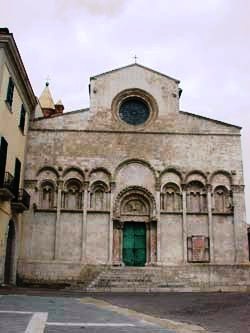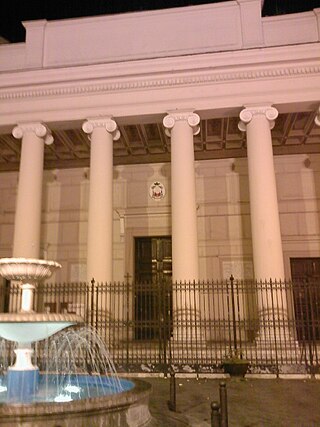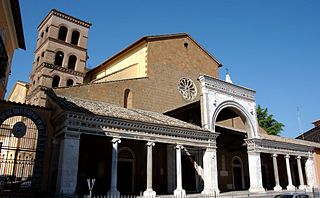History
In 1239, Cardinal Giacomo da Pecorara, suburbicarian Bishop of Palestrina, was sent by Pope Gregory IX to France as papal legate, to deal with the Albigensian heresy. [3] When he stopped in Savona, he removed the parish of Noli from the diocese of Savona with papal authorization, and established a new diocese of Noli. [4] He assigned it as a suffragan of the archdiocese of Genoa, even though Savona remained a suffragan of the diocese of Milan. [5] On 25 April 1249, Pope Innocent IV confirmed the city status of Noli, and the cathedral status of S. Paragorius. [6]
The cathedral was served and administered by a corporation called the Chapter, which, at Noli, was composed of one dignity (the Archpriest) and five canons. This arrangement continued through the end of the 18th century. [7] When Noli was joined with Savona in 1820, the Chapter of Nola consisted of the Archpriest, the Dean, the Theologus, the Penitentiary, and four other canons. [8]
The first bishop of Noli was Guglielmo Contardi, who had already been Bishop-elect of Brugnato, a suffragan of the archdiocese of Genoa, since 1230. [9] In fact, Guglielmo was bishop-elect of both dioceses, aeque personaliter, from 1239 to 1245, when the two dioceses were separated by order of Pope Innocent IV. [10] On 11 August 1247, Pope Innocent IV wrote to the archbishop of Genoa, informing him that the people of Noli were demanding a bishop of their own. Bishop-elect Guglielmo had already ceased to govern Noli, but had been appointed administrator in spiritual and temporal matters. The pope ordered the archbishop to install Frater Philippus, O.P., as their procurator. [11] On 20 April 1249, Pope Innocent signed a bull directed to the bishop of Noli, "in sacra Petri", taking the Church of Saint Paragorius of Noli under the protection of S. Peter and himself, and confirming that Noli was a suffragan of the archdiocese of Genoa. [12] On 6 February 1253, Pope Innocent wrote to the bishop of Noli, recalling that the monastery of S. Eugenius on the island of Bergaggi, which should have been handed over to the diocese of Noli, and which the archbishop of Genoa had ordered to be placed in the possession of the provost of Genoa, who was then bishop-elect of Noli (Philippus, O.P.), was being held by the podestà, council, and commune of Genoa, who were excluding all occupiers. The pope had ordered the monastery and island be restored to the bishop of Noli. In passing, the pope noted that Philippus' successor was deceased. [13]
After his installation as bishop, Bishop Leonardo Trucco (1572–1587) realized that, after serving as Noli's cathedral for 330 years, San Paragorio was no longer adequate for the needs of the bishop and the diocese. It was outside the walls of the town and inconvenient of access. Bishop Trucco therefore wrote to Pope Gregory XIII, proposing that the episcopal seat be moved inside the city, to the church of S. Pietro. In an apostolic letter dated 22 October 1572, the pope granted the bishop's petition and authorized the transfer. [14]
In 1710, the city of Noli had a population of c. 1100. [15] In 1737, the population of the city had risen to c. 1300 persons. [16]
On 8 December 1820, with the bull "Dominici Gregis", Pope Pius VII joined the diocese of Savona and the diocese of Noli in one bishop, aeque personaliter under the title "Savonensis et Naulensis." [17] He cited as justification the small number of faithful and the diocese of Noli's inadequate income. [18]
On 30 September 1986, Pope John Paul II ordered that the dioceses of Savona and Noli be merged into one diocese with one bishop, with the Latin title "Dioecesis Savonensis-Naulensis". The seat of the diocese was to be in Savona, whose cathedral was to serve as the cathedral of the merged diocese. The cathedral in Noli was to have the honorary title of "co-cathedral"; the Chapter of Noli was to be a Capitulum Concathedralis. There was to be only one diocesan Tribunal, in Savona, and likewise one seminary, one College of Consultors, and one Priests' Council. The territory of the new diocese was to include the territory of the suppressed diocese. The new diocese was a suffragan of the archdiocese of Genoa. [19]

















